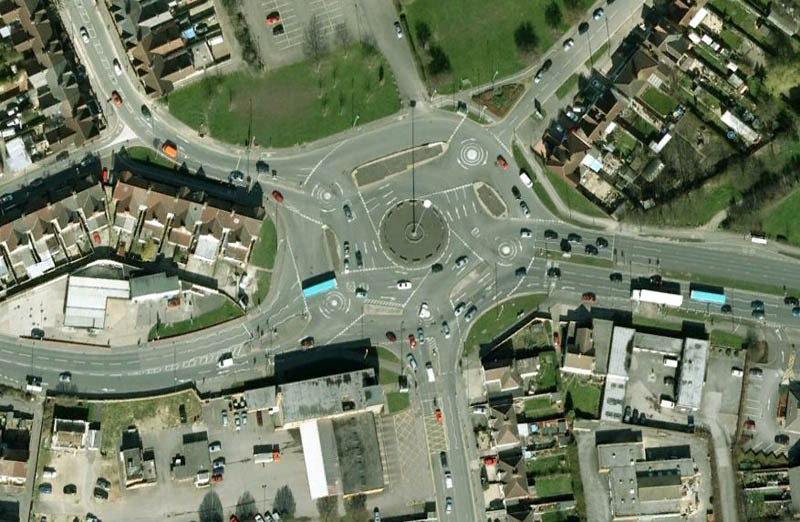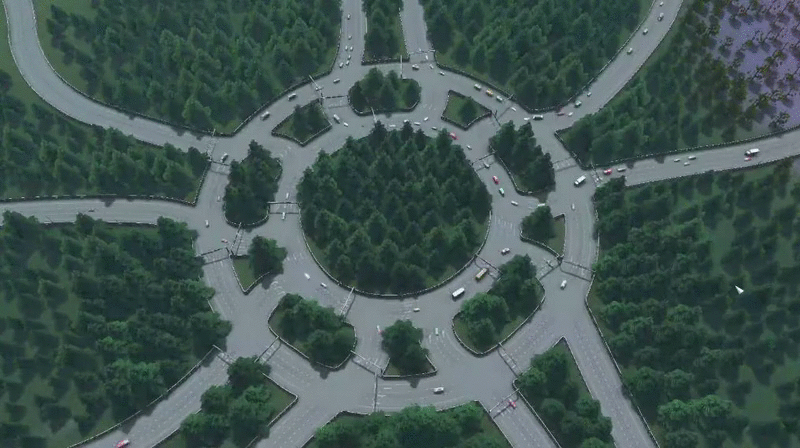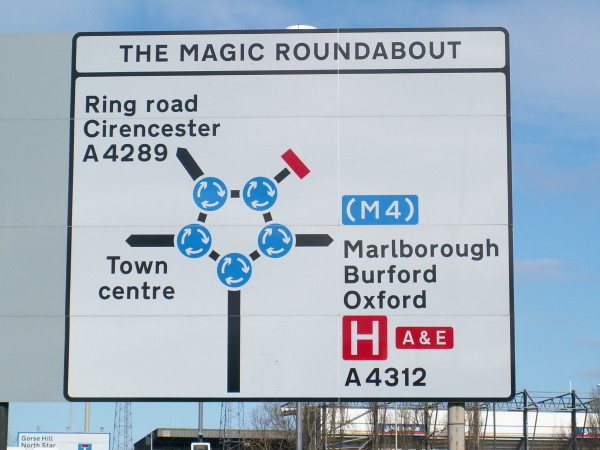Popular in countries such as Great Britain, roundabouts are demonstrably more efficient at moving traffic than four-way stops and other types of intersections. Yet in many places, including the United States, they have failed to become widely adopted.
There are various possible explanations for this reluctance. Some experts point to historical differences in infrastructure evolution and governmental investment, while others posit that a British culture of collaboration is not a part of the American psyche. Or maybe, just maybe, Americans just took one look at this particular roundabout and drove off screaming into the night.

Swindon, England, is home to what may be the most confusing-looking intersection ever created: the world’s first “magic roundabout” (also known as a “ring junction”).
The complex interchange actually consists of five separate smaller roundabouts supporting clockwise traffic, all situated around one larger central roundabout that runs counterclockwise.

Despite its frightening appearance, this configuration is far more efficient than the conventional single-ring roundabout. It has been adapted to create other ring junctions around Britain.

In such roundabouts, each peripheral circle facilitates car entries and exits from an associated feeder road. Experienced drivers can traverse the intersection in more direct and efficient ways, saving time. Less proficient motorists may choose to go with the flow, cycling around the edges until they reach their desired exit. For drivers going from one end to the other, a magic roundabout can enable traversals that are up to twice as fast as conventional roundabouts would allow.
Overall, traffic jams in Swindon have been greatly reduced thanks to this design strategy, even with traffic growth over time, though the subjective experiences of unfamiliar drivers may vary:
Designed by engineer Frank Blackmore of the British Transport and Road Research Laboratory, this now-famous Swindon intersection was constructed in 1972. Originally titled County Islands, the junction was quickly nicknamed the Magic Roundabout, which eventually became its official moniker.
Blackmore developed his design by testing single roundabouts as alternatives to rectilinear intersections, then he began adding double, triple, and quadruple variants:

Initially, traffic police were stationed at each smaller roundabout to make sure drivers could understand what was expected of them. Experimental success led to signage replacing these officers.

The Magic Roundabout still has its critics. It was voted the worst roundabout by a British insurance company, named one of the world’s worst junctions by a motoring magazine, and ranked as one of the ten scariest intersections in a BBC News survey.
Despite this negativity in the popular press, the Swindon roundabout has a surprisingly excellent track record when it comes to safety and overall performance. The overtly-complex appearance of the intersection belies a relatively simple set of rules governing driver behavior:
- Avoid collisions
- Follow the lines and arrows
- Give way to people already on the roundabout
- Continue toward your destination
Tom Scott, producer of the video below, compares the appearance of disorder in the intersection to complex emergent behavior exhibited by groups of birds. As he points out, even a few simple rules can lead to what looks like chaotic flocking patterns to an outside observer:
While this simplicity remains a key asset, the relative safety and efficiency of magic roundabouts are enhanced by the slowness of traffic moving through them, as well as increased awareness of drivers. Uncontrolled intersections, roundabouts and otherwise, force motorists to pay more attention to the road and their surroundings, relying on their wits instead of signs or signals.
There are those who argue for extreme interpretations of this approach, a “shared spaces” philosophy skeptical of lights, signs, curbs, and even lane markings. This kind of traffic management minimalism may be more uncomfortable, but the alertness it engenders can serve to keep drivers attentive, their eyes and minds on the cars, bikes, and pedestrians around them, as well as the road ahead.
Update: we discuss roundabouts even more in The 99% Invisible City!



Comments (15)
Share
I lived in the Swindon area for over a decade, and traveled through the Magic Roundabout on a regular (though not daily) basis. It was a bit daunting the first few times, but with so many other roundabouts in the area, it eventually became second nature. I’d like to see more of them here in the US (though maybe not on the Magic scale).
I enjoy how slow everyone is moving in the explanation video for the “magic roundabout” unfortunately in the US, at least where I live out west, no one ever drives that slow, instead taking the roundabouts on two wheels. Perhaps the magic roundabout would be a safer way to move cars but only if everyone was following the same speed limit.
On a side note, I remember when i first came upon this wonderful road pattern in Boise that is supposed to do the same thing, speed up traffic and be safer: http://itd.idaho.gov/projects/D5/ChubbuckInterchange/index.html the diverging diamond. Anything is better than a 5 or 6 point intersection.
Interesting. When I moved from the UK to California, I noticed the opposite. I couldn’t believe how slowly people reacted to the change in traffic lights in LA. It came to a head one day when a British friend was driving and beeped/honked a slow-starting car only to be confronted by the drivers’ gun.
Give me a roundabout over a gun any day.
I was scratching my head as to why the sight lines would be decimated by all the trees, and why there were no other signs of civilization with so many roads around. This makes much more sense after reading your comment. Thank you, ruarai!
There is another good example in Colchester…
https://www.google.ch/maps/place/Colchester,+Essex,+UK/@51.8843663,0.932342,241m/data=!3m1!1e3!4m2!3m1!1s0x47d8e24e12f62f05:0x175d5f1c455091de?hl=en
The additional space between the smaller roundabouts along the route of the big roundabouts makes this seem not quite so intimidating. (At least from the satellite view…)
It’s a intriguing and space-saving design for car traffic. Are there no pedestrians in Swindon, or have the planners eliminated any ped destinations?
It’s an interesting solution, but I realized if all the streets were on a grid, then the roundabout would be not be needed. If we had a grid, the confusion wouldn’t be needed.
Not sure I understand. As a grid (say Manhattan’s street plan), is a grid. Furthermore, we can call a place like Manhattan with all its one-way streets and avenues ‘a square-like roundabout with traffic lights’ (see the last video in the article which further explains how city blocks with one-way traffic is one step away from a roundabout: https://www.youtube.com/watch?v=vnUO6Ey70qI ).
Just a little nitpick: Great Britain is an island, not a country…
“Despite its frightening appearance, this configuration is far more efficient than the conventional single-ring roundabout, and has been adapted to create other ring junctions around Britain:”
That GIF is from the video-game Cities: Skylines. Needless to say, it’s not a ring junction in Britain.
Well, you posted a gif from a game called Cities:Skylines, that’s not an existing roundabout….
What’s a comments section without some regional rivalry. Although Swindons bland series of traffic islands may predate Hemel Hempstead’s Plough roundabout by a few months, the pictures in the below article from A Swindon newspaper (ironically) clearly show which is the most magical. What demonstrated this better than the fact Swindon’s local authorities had to officially christen theirs the ‘magic roundabout’ because unlike Hemel’s it wasn’t an obvious and inevitable nickname. http://www.swindonadvertiser.co.uk/news/5065340.Who_s_got_the_best_roundabout___Hemel_or_Swindon_/#
On a more helpful note. The articles description of the mechanics of these junctions is not correct. Traffic flows around the larger central ’roundabout’ in both clockwise and counterclockwise directions. It is this feature that makes them unique and more confusing than the multi lane roundabouts that are commonly found at the junctions of British dual carriageways. An easier way to conprehend the junction is as 6 entirely discrete roundabouts (obeying all the conventional traffic rules) arranged in a circular pattern and connected by normal (if very short) two way roads.
An important omission is that Magic Roundabout is also the name of a beloved British children’s TV series of the 1970s https://m.youtube.com/watch?v=c3DcChXNyYQ
If the road version is still confusing, this might help. A normal roundabout is a one-way street bent around into a circle, with T junctions where it meets the feeder roads. A magic roundabout is a two-way street bent around into a circle, with small normal roundabouts where it meets the feeder roads.